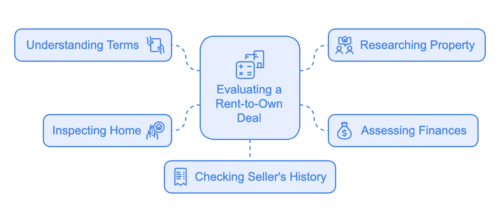
Guide to Safe Apartment Tours
April 10, 2020
Common Mistakes That Cause People to Lose Their Housing Vouchers
May 1, 2020Rent-to-own agreements promise a pathway to homeownership that seems too good to pass up. But are they as great as they sound? For renters looking for an affordable way to buy a home, these deals can be appealing, yet they often come with hidden risks.
At Section 8 Shield, we’re here to help renters like you understand the pros and cons of rent-to-own agreements so you can make informed decisions.
What Is Rent-to-Own?
A rent-to-own agreement allows you to rent a home with the option to purchase it after a set period. Part of your monthly rent goes toward the eventual purchase price. There are two main types of agreements:
- Lease-Option Agreement: You have the option to buy the home at the end of the lease but aren’t obligated to.
- Lease-Purchase Agreement: You’re required to purchase the home at the end of the lease, regardless of financial circumstances or market conditions.
The Pros of Rent-to-Own Agreements
Rent-to-own can be a viable option for renters in specific situations. Here are some of the potential benefits:
- Pathway to Ownership
It’s an opportunity for renters who can’t secure a mortgage right now but expect to in the future. - Credit Repair
Many agreements give you time to improve your credit score while you work toward qualifying for a loan. - Locked-in Purchase Price
In a rising housing market, locking in today’s price could save you money in the long run. - Partial Rent Credit
A portion of your rent may go toward the purchase price or down payment, helping you save for homeownership.
The Risks of Rent-to-Own
While the benefits sound appealing, rent-to-own agreements often come with significant risks:
1. Non-Refundable Fees
Most agreements require an upfront option fee, which can range from 1% to 5% of the purchase price. This fee is non-refundable if you decide not to buy the home or fail to meet the terms.
Tip: Make sure you fully understand the terms of the option fee before signing.
2. Higher Rent Payments
Rent-to-own agreements typically come with above-market rent, as a portion is allocated toward the future purchase. If you fail to buy, this extra money is lost.
3. Maintenance Responsibility
In many agreements, renters are responsible for maintenance and repairs. This can become costly, especially if unexpected issues arise.
Related Article: Check out How to Spot Fake Rental Listings Online to ensure the property you’re considering is legitimate.
4. Market Risk
If the housing market declines, you could end up overpaying for the home based on the locked-in purchase price.
5. Risk of Losing Payments
If you’re unable to qualify for a mortgage or decide not to buy, you lose all the payments made toward the purchase.
How to Evaluate a Rent-to-Own Deal
Before signing a rent-to-own agreement, consider these steps:

- Understand the Terms
Read the contract carefully and understand all fees, responsibilities, and conditions. If possible, consult a real estate attorney. - Research the Property
Verify that the property title is clear and that the landlord has the legal authority to sell. Use your local tax assessor’s database or contact your housing authority for help. - Assess Your Finances
Make sure you can afford the rent and are confident in your ability to secure financing when the time comes. - Inspect the Home
Conduct a professional home inspection to identify potential issues before you commit. - Check the Seller’s History
Research the landlord or company offering the rent-to-own deal. Look for complaints or lawsuits that could indicate fraudulent practices. Related Article: Learn more about How to Check if a Landlord or Rental Agency Is Legitimate.
Common Rent-to-Own Scams
Because rent-to-own deals are less regulated than traditional real estate transactions, scammers often target renters. Be on the lookout for:
| Phantom Homes | Scammers advertise homes they don’t own and collect payments before disappearing. |
| Unfair Contracts | Some agreements are written to favor the seller, making it nearly impossible for the renter to fulfill the terms. |
| Hidden Fees | Be wary of contracts with vague terms about fees. Always ask for clarity. |
If you suspect a scam, read our guide How to Recognize and Avoid Fake Eviction Notices.
Alternatives to Rent-to-Own
If a rent-to-own agreement feels risky, consider these alternatives:
- Traditional Renting with Savings
Rent while building savings for a down payment on a conventional mortgage. - First-Time Homebuyer Programs
Look into programs that offer down payment assistance or favorable loan terms for first-time buyers. - Affordable Housing Options
Explore programs offered through HUD or your local housing authority.
Final Thoughts on Rent-to-Own
Rent-to-own agreements can work for some renters, but they come with risks that should not be overlooked. If you’re considering this option, take the time to research thoroughly, consult professionals, and read the fine print.
Brian H.
Renter in Texas.At Section 8 Shield, our mission is to keep renters informed and empowered. If you’re considering a rent-to-own deal or need help navigating the rental process, explore our other resources to stay protected and make smart decisions. Together, we can make renting safer for everyone.




